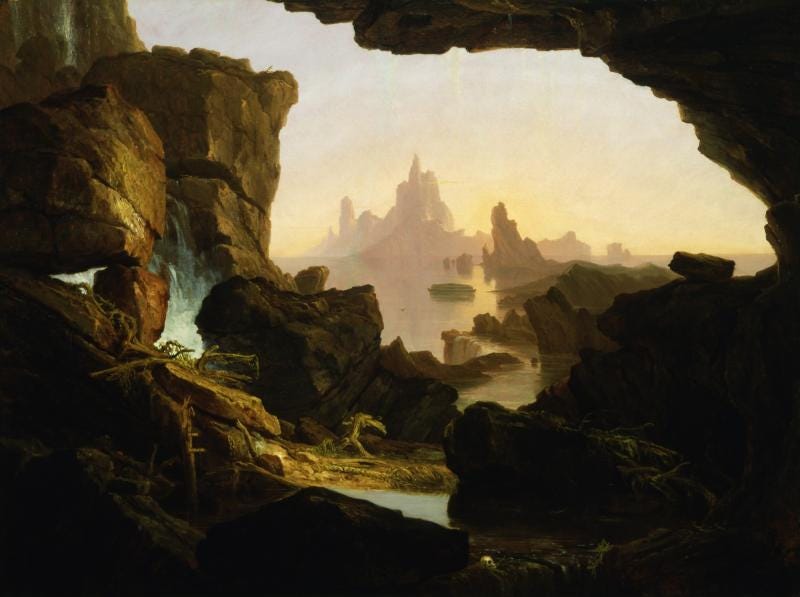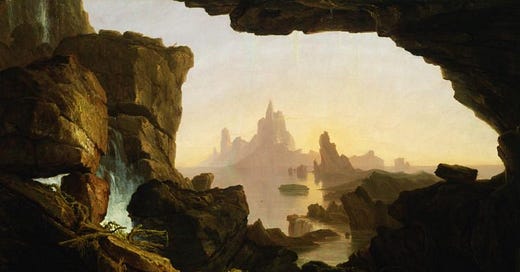Don’t Breathe the Air
A Sea Changed, Part 4. Theme song by Tom Lehrer. Plus: teaser for an upcoming series on the Unseen consequences of AI
In this series, I try to bear witness to the changed Aral sea – an Ireland-sized lake that became a desert in 50 years, which is one of the worst ecological disasters in human-recorded history. I’ll try to answer these questions: What can we learn from this disaster? Where does this story end? Has the die really been cast?
See part 1 for a storm of salt, part 2 for the fisherman in the desert, part 3 for white gold (or, the snowballing of solutions into big problems), part 5 for candy and vodka.
Teaser: in a couple of weeks, in a new essay series, we’ll look at the more fundamental consequences of AI — that are still Unseen.
Today’s theme song is supplied by Tom Lehrer, a timeless singer and comedian.
You can judge a lake by the color of its water. Rainbow colors in a river are screaming, “Don’t come near!” Blue waves are inviting you to get closer and play around.
Or so I thought, until I got out of the Lada Niva, and landed on the salt-soaked floor of the dried-up Aral sea. Once upon a time, this “beach” I stepped on, was under more than 30 meters (~100 feet) of water.
I haven't even finished a first breath through the double-layered medical mask, and my nostrils have already started to hurt. The stench — a mix of sulfur, bleach, rotten eggs, and decomposed carcass — startled me, because it contradicted what I saw:
Clean blue waves synced to rhythms of the wind. Layers upon layers of white foams occupied the berm, and laid a thick moat around the water.
I felt the vial and lab kit in my pocket, and decided to walk to the water. I knew that for years, not one drop of water from the Amu river reached the lake. This might be the last stand of the once mighty Aral sea, I thought. I had to sample the water for a souvenir!
"Don't touch the water!" I heard Nikolai Genrikhovich shout from a distance behind me, "It's poison!"
Of course I knew that. I already put on medical gloves, readied a lab kit, and tied the vial to a long string. I had done my research: this “lake” water was 10 times saltier than actual sea water. No marine species survived, and all fish went extinct. It was a lifeless lake, and I knew it.

As I stepped closer to the foams, the stench grew stronger and stronger. The sulfur, bleach, rotten eggs, and decomposed carcass were starting fires in my nose. I had barely toed on the edge of the foams, and my throat tightened up to surrender moist coughs. My eyes, protected by a pair of sunglasses, began to tear up a little too.
It wasn’t water or foam. It was a cocktail of water, run-offs of fertilizers and pesticide, industrial dumps, maybe even anthrax, and god-knows-what-else.
So I started to retreat, backing away from the waves in a scurry. I was half-intimidated, and half-humbled by what I have encountered so far.
Humbled and intimidated indeed. First, on the road here, I was astounded by the scale of water-hungry cotton production in deserts. After arriving at Muynak, I was knocked out by a storm of salt. After getting into the desert, I was surprised by a fisherman captain in the dunes, where his maritime kingdom had turned into salty ashes. Here, after navigating unmarked roads in a young desert to reach the south Aral sea, I was presented with a test of survival: trying not to breathe the air.
Years ago, in jest, Tom Lehrer sang "don’t drink the water, and don't breathe the air!" If, like me, Tom had approached those stinky foams; or, like my host family, had lived in Muynak for years, he would have meant it. Nobody could breathe the local air, drink the local water, and stay healthy for long:
I spat out everything and washed my mouth, the moment I dipped on my tongue some boiled local tap water. The water tasted terrible: it was 6 times saltier than what’s drinkable.
Children in the neighborhood of my host family were in their late teens, but they didn’t seem to grow a day beyond 10 years of age. The air they breathed everyday had deposited toxins into their bodies, and the toxins made it difficult for their bodies to absorb nutrients and grow.
The closer we got to Muynak, the more tuberculosis (TB) dispensaries I noticed. Local staffers at Doctors Without Borders said the situation was dire. My host family told me that everyone they knew had some blood, lung, or liver dysfunctions, from TB and anemia, to liver and lung cancer.
In more acute hindsight, Tom Lehrer could indeed mean what he sang. He performed the song in 1967: five years after Rachel Carson published Silent Spring, and two years before Ohio’s Cuyahoga river caught fire the last time. The fire spurred into existence the Environmental Protection Agency (EPA), the Clean Water Act, and major amendments to the Clean Air Act in the 1970s — around the same time that the USSR legislated very similar laws.

***
As I was backing away from the stinky foams and toxic waves, wind changed directions. The air became more tolerable to breathe. It was a day with excellent visibility, but no trawler appeared anywhere. Nor was there any air-borne species to be seen.
Only an airplane — made out of wood strips — dangled, from a stake planted at a hasty depth. The plane's wings flapped about, with no destination to fly towards. It reminded me: just 30 years ago, when there had been water, Muynak airport had teemed with fishing crews and tourists from Europe and Asia. Soviet bureaucrats especially enjoyed this lakeside retreat. Then the water receded, the Golden Age of Fishing passed into local lore, and the airport was spoken of no more, after the last flight departed. The hammer-and-sickle still perched on the airport’s rusty gate, decades after the USSR had ceased to exist.
I stood next to the Lada Niva, and looked out to the last remains of the Aral sea from a further distance. Lines from “The Waste Land” by T. S. Eliot leapt into my mind:
A heap of broken images, where the sun beats,
And the dead tree gives no shelter, the cricket no relief,
And the dry stone no sound of water.

Before I could ponder on these lines, I heard Nikolai exclaim: “You didn’t die from poison!”
“Of course! Because we are going to Vozrozhdeniya Island,” I said. Vozrozhdeniya island had been a USSR-era bio-weapons lab and test site, then decommissioned and abandoned. It was about 95 kilometers (~60 miles) further into the desert.
“So poison isn’t enough for you,” Nikolai said, “What do you seek? Anthrax? Smallpox?”
“I’m joking,” I said, “I don’t want to get lost in the desert. I don’t think you want it either.”
On the hour-long ride back to Muynak, I chewed on licorice candy and thought about those Eliot lines more. Perhaps one day, broken images shall be made whole, dead trees shall give shelter again, and water shall fill the canyons and recover the dunes. However impossible this sounded, I was reminded of what Nikolai — a Russian Pollyanna — liked to say on these road trips: one must believe in the impossible and unknowable. I suppose that he was right.
Thank you for reading Earthly Fortunes. If you like it, please share it. Subscribe for free to join me on random trips into deserts and other curious places.
Let me know your thoughts in an email reply, in the comments, or DM me on Twitter or Instagram!




I immediately Googled Aral sea. Saddened by its fate, i read on, looking for other articles in this series.
While Aral sea took 30 years to die, many 100 small lakes in Bangalore took just a fe years, but we're covered with commercial activity. So their toxicity is under control, but moving slowly towards the same fate. Dystopian scenery is hard to forget, specially with no solution in sight.
Another riveting article, Helen. Similarly to Karena, I'm looking forward to rereading your work - in order - over a good cup of coffee.